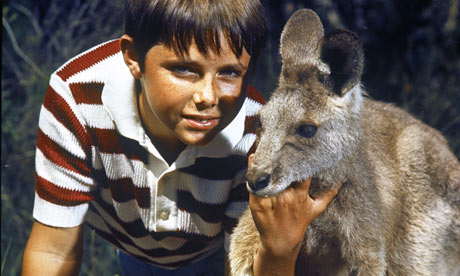
Until last night, I had only dim memories of Skippy. I could only really summon up the song, the little kangaroo, and a vague sense of it all being slightly creepy. On the whole, I preferred Gentle Ben, the big friendly bear – and when it came to choosing my first lunchbox, I opted for a Flipper one. But as Skippy: Australia's First Superstar (BBC4) made clear, the bush kangaroo was a favourite not just in his homeland, but in America, Japan and most of Europe. Only Sweden refused to transmit Skippy, for fear that children would grow up thinking animals could communicate with humans, operate radio equipment and play the drums. They were probably right; between Skippy, Ben and Flipper, I more or less spent my childhood thinking the dog's refusal to follow my instructions was a simple matter of insubordination.
The truth, sadly, is that Skippy was not the prodigy he (or she – there were nine in all) seemed. Kangaroos are, as several people who worked on the series recalled, "dumber than sheep" and completely untrainable. Skippy's acting range was restricted to looking in the direction of a crew member banging a cake tin; this would take place in the brief minutes after they let him out of his sack and before he came to his senses and ran off. His feats of manual dexterity were performed by a human wielding two kangaroo-clawed backscratchers.
This engaging account of how Skippy became a global phenomenon was still fascinating, funny and, as I suspected all those years ago, a little bit creepy. Producer Lee Robinson wanted to make a children's series and, having seen Flipper, was casting about for an antipodean counterpart. He suspected that Australians, who were fed a strict diet of American TV imports at the time, would find a show about a clever kangaroo terribly parochial, so he sold the series overseas first, in Britain and America. A homesick Germaine Greer was an immediate, if unlikely fan. "I used to watch it with the sound turned off," she said. "There were all kinds of things about it that were unbearable. But the landscape! And the light!"
In some ways, the rough and ready lives of the production team mirrored that of the show's characters – they relaxed in the bush, swam in shark-infested waters and operated in an atmosphere of unremitting sexism. They walked around with wombats hanging off them. Child actors played poker with the adults, and they set real bush fires when the story called for it. The main difference between the behind-the-scenes scenes and the series itself was Skippy. In the show, Skippy was patient and wise and capable of dialling a phone. In the real-life footage he was mostly trying to escape. That's why it took nine kangaroos to play him. Or her, depending.
The idea of a saviour sibling, a child conceived through IVF in order to provide treatment for an older brother or sister, flags up a lot of ethical issues for a lot of people, though not, by and large, people with desperately ill children who might benefit. For the two couples featured in Having A Baby To Save My Child (BBC1), the room to consider the ethical questions would be a bit of a luxury. They're running out of time, luck, and money.
Both families have small children diagnosed with Fanconi anaemia, a rare genetic disorder that leads to bone marrow failure. The most successful bone marrow transplants use matching sibling donors, and since neither child has a sibling who is a match, creating one is the only option, by screening and then implanting embryos.
Emma Loach's sensitive but heartbreaking film showed the controversial procedure to be a battle against daunting odds. David and Samantha, who have already lost a child to Fanconi, go through repeated appeals to get the NHS to fund a single cycle of IVF. Meanwhile, Tom and Alison have paid for four cycles, at £7,000 each, without success. These people are plumbing boundless depths of worry, frustration and fear, but there isn't any question of not carrying on. Tom, who is a doctor, sees how genetic misfortune has altered his view. "Parents of children who get very serious illnesses occupy a different position in life," he says. "You start to think differently from a lot of people around you. It's a parallel universe." It's a place where ethical arguments are the least of your problems.

